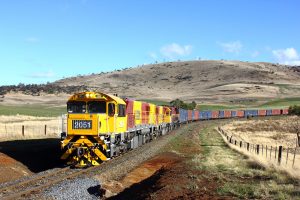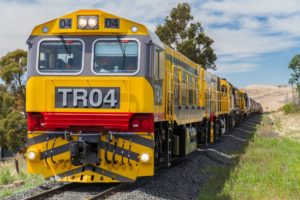History of the 2050 and TR class locomotives.
2050 class
Originally built as the 2150 class by Commonwealth Engineering (on behalf of Clyde Engineering) between 1978 and 1979. The locomotives operated with Queensland Rail until TasRail purchased four of the locomotives in 2011 from QR National. The four locomotives were road transported from Brisbane to Devonport, and finally railed to the East Tamar workshops for modifications and commissioning. They entered TasRail service as the 2050 class in February 2012, still in the Queensland Rail maroon and yellow livery.
All four locomotives were stored in 2015 after the introduction of the TR class and were briefly offered for sale. With no sale forthcoming, two of the locomotives returned to service in 2018 due to locomotive shortages.
To read more history of the 2050 class that operate in Tasmania then Click here.

TR class
Faced with an ageing locomotive fleet, TasRail called for Expressions of Interest in the supply of new locomotives in March 2011. Seven proposals were received, and in August 2011 it was announced that Bombardier (Europe), Progress Rail (USA), National Rail Equipment Corporation (USA) and CSR Qishuyan (China) had been selected to proceed to formal tenders. On 13 December 2011 it was announced that Progress Rail (part of the Caterpillar group), in conjunction with its Australian partner Downer Rail had been awarded the contract to construct 17 locomotive of their PR22L model. The contract was worth more than $60 million.
The first two locomotives (TR01 and TR04) were delivered to Tasmania in November 2013, and soon underwent commissioning trials. Further batches arrived every few months until all 17 locomotives were delivered by mid 2014.
The locomotives are fitted with Caterpillar 3512CHD engines, Zeit microprocessor traction control system and were also designed to be modified from 18 tonne axle load (108t gross) to 16 tonne axle load (96t gross) to enable work on the Melba Line. This was to be achieved by removing 1 tonne weight blocks from each of the four corners of the locomotive and limiting the overall fuel load. After some initial light engine clearance trials, the TR class were deemed unsuitable for use on the Melba Line and thus have never undergone the axle loading modifications.
The TR class have been plagued with mechanical and electrical reliability issues since they have entered service.

